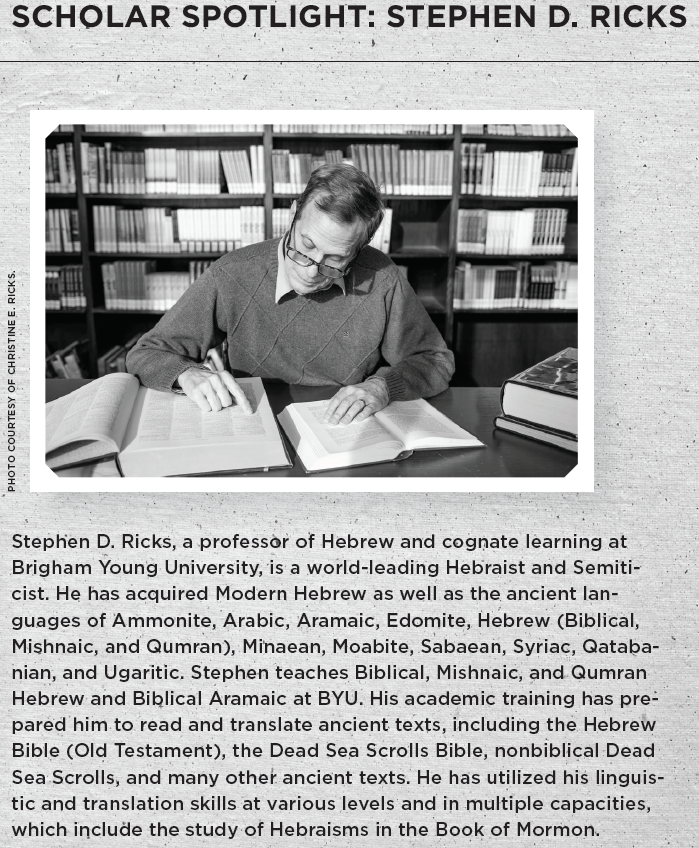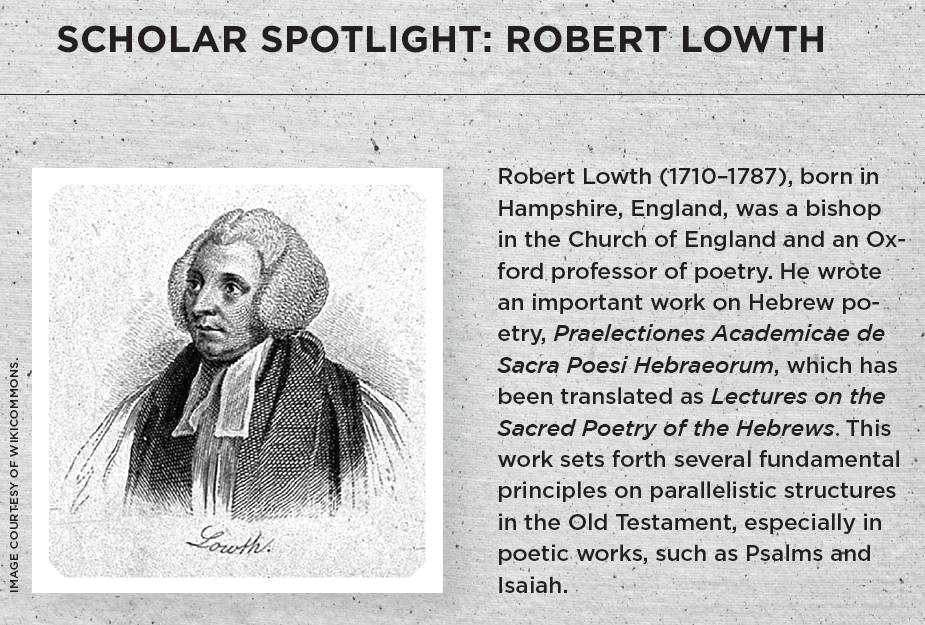Extended Parallelism
Donald W. Perry, “Extended Parallelism,” in Preserved in Translation: Hebrew and Other Ancient Literary Forms in the Book of Mormon (Provo, UT: Religious Studies Center, Brigham Young University; Salt Lake City: Deseret Book), 27‒34.
"the words of the angel, . . . of Zenock, . . . of Zenos" (1 Nephi 19:10)
Extended and expanded parallelism often features exact words or phrases that are repeated in the framework of a verse or two. Again we see that repetition is used to achieve desirable emphasis. When repeated words are set in a particular order that is artfully sustained over several lines, the resulting parallelistic structure can evoke admirable beauty and elegance.
In the following three examples from the Old Testament,[1] the letters A–D and their respective indentions distinguish corresponding lines.
Planting and Eating
A And they shall build houses,
B and inhabit them;
C and they shall plant vineyards,
D and eat the fruit of them.
A They shall not build,
B and another inhabit;
C they shall not plant,
D and another eat. (Isaiah 65:21–22)
In prophesying of the millennial earth, the great prophet-poet Isaiah here sets forth four key words that are paired—build and inhabit, plant and eat—and then thoughtfully repeats them within negative constructions, forming a double ABCD pattern.
God’s Jealousy, Humankind’s Vanities
A They have moved me to jealousy
B with that which is not God;
C they have provoked me to anger
D with their vanities:
A and I will move them to jealousy
B with those which are not a people;
C I will provoke them to anger
D with a foolish nation. (Deuteronomy 32:21)
The prophetic teaching in the first A–D sequence is that because vanities and foolishness draw people away from God, he is moved to jealousy. The second sequence expands upon that idea to convey a caution—namely, that God will cause such foolish people to experience a similar kind of unwelcome provocation, turning their sin upon themselves.

God’s Hand Is Stretched Out
A This is the purpose that is purposed upon the whole earth:
B and this is the hand that is stretched out upon all the nations.
A For the Lord of hosts hath purposed, and who shall disannul it?
B and his hand is stretched out, and who shall turn it back? (Isaiah 14:26–27)
This passage pertains to the Lord’s unparalleled power—that is, he “purposed” (or “planned”),[2] and then he stretched out his hand so that his counsel would be appropriately carried out. In this extended parallelism, the two A lines give prominence to God’s “purposing” and the two B lines call attention to his outstretched hand. The corresponding expressions whole earth and all the nations, as well as the comparable questions who shall disannul it? and who shall turn it back?, mean that no mere mortal can overpower the Lord’s superior strength.
There are dozens of extended parallelisms in the Book of Mormon.[3] The five examples that follow focus on Jesus Christ, particularly his atoning mission.
The Message of Christ and the Messengers
A the God of Jacob, yieldeth himself,
B according to the words of the angel,
A as a man, into the hands of wicked men, to be lifted up,
B according to the words of Zenock,
A and to be crucified,
B according to the words of Neum,
A and to be buried in a sepulchre,
B according to the words of Zenos. (1 Nephi 19:10)
In a powerful way, the A lines in this verse set forth four truths about Jesus Christ’s atoning mission—namely, he will yield himself, be lifted up, be crucified, and be buried in a sepulchre. Four different messengers of these truths are presented in the B lines: an unidentified angel, Zenock, Neum, and Zenos. Each AB unit follows the pattern of message of Christ/
Jesus Speaks and the Nations Shall Write It
A For behold, I shall speak unto the Jews
B and they shall write it;
A and I shall also speak unto the Nephites
B and they shall write it;
A and I shall also speak unto the other tribes of the house of Israel . . .
B and they shall write it;
A and I shall also speak unto all nations of the earth
B and they shall write it. (2 Nephi 29:12)
This passage engages the reader by expanding the size of the groups in the A lines from a single tribe of Israel (the Jews, or Judah) to two tribes of Israel (the Nephites, consisting of the tribes of Ephraim and Manasseh), to “the other tribes of the house of Israel,” and finally to “all nations of the earth.” The B lines with their refrain “and they shall write it” alternate with the A lines to form a compelling poetic passage about Jesus Christ, who speaks to various tribes and nations.
Three Essentials of Jesus’s Sufferings
A wherefore they scourge him,
B and he suffereth it;
A and they smite him,
B and he suffereth it.
A Yea, they spit upon him,
B and he suffereth it. (1 Nephi 19:9)
The words here about Jesus Christ’s sufferings are brief but doctrinally crucial. The A lines tell how men will abuse Christ—they will scourge him, smite him, and spit upon him—before he is subjected to extreme abuse upon the cross, leading to death (treated in the extended parallelism of 1 Nephi 19:10 discussed earlier in this chapter). The B lines emphasize Christ’s ignominious suffering and the complete and uncontested yielding of his will by repeating the refrain “and he suffereth it.” The short six lines accrue in their effect to create a forceful image regarding a critical time in Christ’s life, shortly before his crucifixion.

The Principle of Mercy through the Son
A If ye will repent,
B and harden not your hearts,
C then will I have mercy upon you,
D through mine Only Begotten Son;
A Therefore, whosoever repenteth,
B and hardeneth not his heart,
C he shall have claim on mercy
D through mine Only Begotten Son,
unto a remission of his sins; and these shall enter into my rest. (Alma 12:33–34)
This passage teaches the vital doctrine of mercy, which is a gift from Jesus Christ. The passage’s stylistic structure is arresting—four repeated elements (ABCD/
Two Categories of Death—Jesus Is the Deliverer
And because of the way of deliverance of our God, the Holy One of Israel,
A this death,
B of which I have spoken,
C which is the temporal,
D shall deliver up its dead;
E which death is the grave.
A And this death
B of which I have spoken,
C which is the spiritual death,
D shall deliver up its dead;
E which spiritual death is hell. (2 Nephi 9:11–12)
The repetitive pattern Jacob uses here contrasts temporal death with spiritual death. An important contrast is presented in the two E lines—those who die a temporal death go to the grave, but those who die a spiritual death go to hell. The climactic idea, presented at the beginning of the passage, states clearly that the “way of deliverance” from both temporal and spiritual death is “the Holy One of Israel,” who is none other than Jesus Christ.
Notes
[1] For an analysis of complex parallelisms, including extended and expanded parallelistic structures, examine Bullinger, Figures of Speech Used in the Bible, 351–73.
[2] To modern ears the KJV’s “purpose that is purposed” (Isaiah 14:26) may sound a bit awkward; the first line of this passage can also be translated to read, “This is the plan that was planned for the whole earth” (author’s translation).
[3] For more on extended and expanded parallelisms in the Book of Mormon, see Parry, Poetic Parallelisms, xxii–xxiv. For a list of instances in the Book of Mormon, see the index of poetic forms therein, pp. 566–67, under the entries “extended alternate” and “repeated alternate.”
